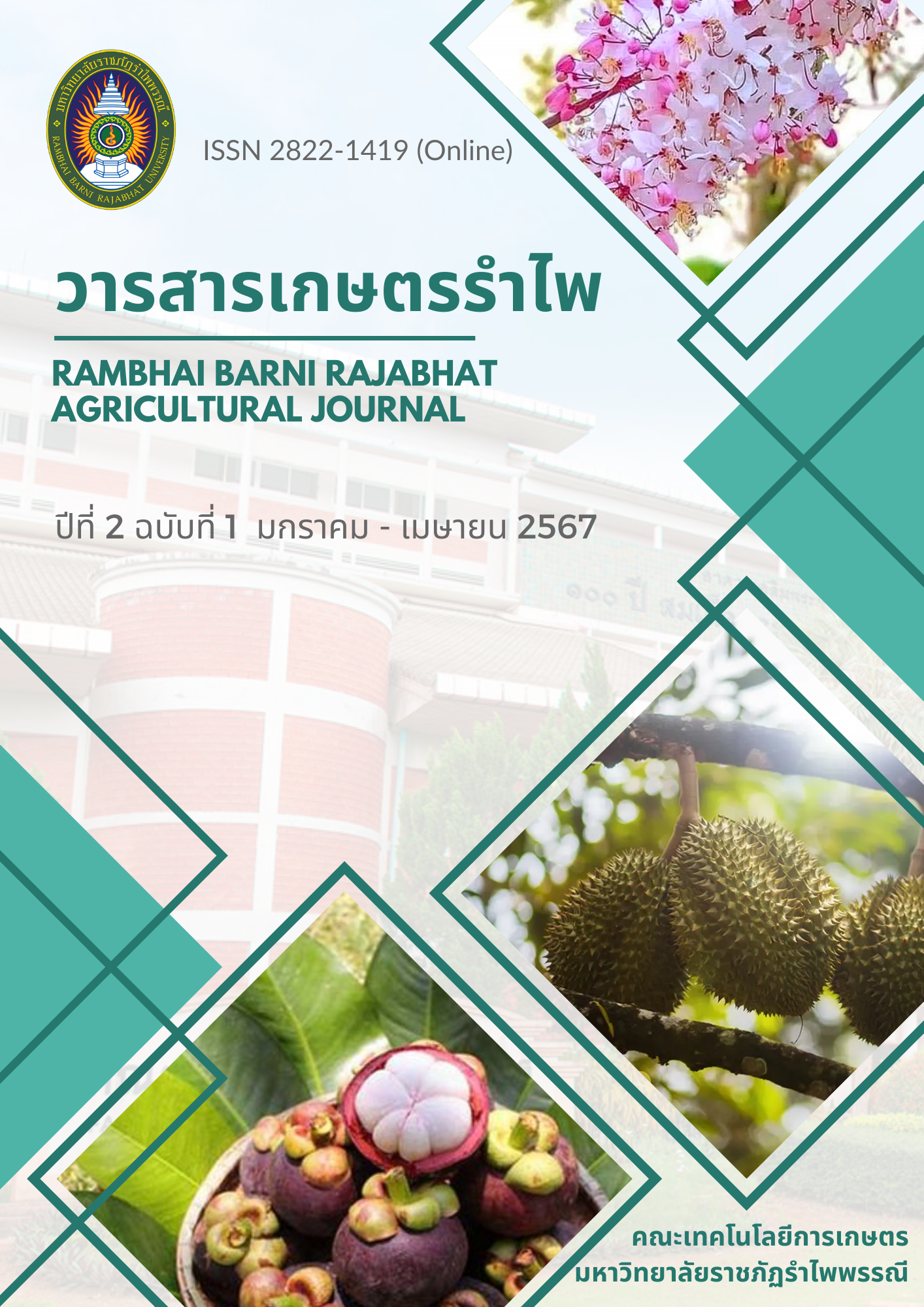The Study of Biology and Predation Efficiency of Ring-legged Earwig (Euborellia annulipes (Lucas)) on Mustard Aphid (Lipaphis erysimi (Kaltenbach))
Main Article Content
Abstract
The study on predation efficiency of ring-legged earwig (Euborellia annulipes (Lucas)) on Mustard aphid controls was conducted at the laboratory of Biological Control Section, Entomology and Zoology Research Group, Plant Protection Research and Development, Bangkok, Thailand. The study aimed to determine the efficiency and potential utilization of ring-legged earwig (E. annulipes ) to control Mustard aphid. (L. erysimi). This study was comprised two experiments. The first experiment explored the lifespan of E. annulipes through feeding on cat food. Female E. annulipes laid eggs in clusters, which were white and oval-shaped. The results displayed the average duration of each development stage : egg stage, nymph stage (1-5), and male and female stages which were : 9.35±1.37, 42.40±1.89, 86.54±9.61, and 103.71±11.21 days, respectively. Females laid eggs 6-9 times throughout their lifespan, with an average of approximately 51.10±6.41 eggs per cluster each time. The second experiment involved feeding 30 of each small aphid (1-3 instar larvae) and large aphid (4 instar larvae and adults) to each stage of E. annulipes every day (at 2nd, 3rd, 4th, 5th stage, and adult (males and females). The present study showed that at the 2nd, 3rd, 4th, 5th stage, and adult stages (males and females) of E. annulipes were able to consume small Mustard aphids (L. erysimi) at an average of 16.67±10.55, 34.38±14.85, 48.90±15.04, 51.13±11.90, 52.07±18.78, and 56.42±22.84 aphids per day, respectively. The consumption rate of E. annulipes on large Mustard aphids (L. erysimi) was approximately 3.13±1.63, 4.91±3.02, 9.54±5.48, 10.75±8.13, 11.12±5.13, and 12.58±5.45 aphids per day, respectively. The feeding efficiency of E. annulipes from this study will be used as insightful information for farmers to further utilize the ring-legged earwig as a biological control for the infestation of aphids.
Article Details

This work is licensed under a Creative Commons Attribution-NonCommercial-NoDerivatives 4.0 International License.
References
Abramson, C.I., Wanderley, P.A., Mina, A.J.S., Wanderley, M.J.A. (2007). Capacity of earwig Marava arachidis (Yersin) to access fennel plants Foeniculum vulgare Mill in laboratory and field. Ciência Rural, 37(6) : 1524-1528
Capinera, J.L. (2001). Handbook of Vegetable Pests. New York : Academic Press.
Damiri, B.V., Al-Shahwan, I.M., Al-Saleh, M.A., Abdalla, O.A. and Amer, M.A. (2013). Identification and characterization of Cowpea aphid-borne mosaic virus isolates in Saudi. Arabia Journal plantpathology, 95(1) : 79-85.
Devin, P.C. and Stanley, C.H. (1984). Augmentation of European Earwigs (Dermaptera: Forficulidae) for Biological Control of Apple Aphid (Homoptera: Aphididae) in an Apple Orchard. Journal of Economic Entomology, 77(3) : 738–740.
Dinis, A.M., Pereira, J.A., Benhadi-Marin, J., and Santos, S. (2016). A. Feeding preferences and functional responses of Calathus granatensis and Pterostichus globosus (Coleoptera : Carabidae) on pupae of Bactrocera oleae (Diptera:Tephritidae). Bulletin of Entomological Research, 106(6) : 701-709.
Furlong, M.J., Wright, D.J., and Dosdall, L.M. (2013). Diamondback moth ecology and management: problems, progress, and prospects. Annual Review of Entomology, 58(1) : 517-541.
Joice, M.S., Seleghim, A.R., Nunes, G.S., Truzi, C.C., Vieira, N.F., and Bortoli, S.A. Predation of Diatraea saccharalis eggs and neonates by the earwig Euborellia annulipes, Retrieved April 2, 2022, from https://www.sciencedirect.com/science/article/pii/S1049964422001189.
Klostermeyer, E.C. (1942). The life history and habits of the ring-legged earwig, Euborellia annulipes Lucas. Journal of the Entomological Society of America, 15 : 13-18.
Koppenhöfer, A.M. (1995). Bionomics of the earwig species Euborellia annulipes in Western Kenya (Dermaptera : Carcinophoridae). Entomologia Generalis, 20(1/2) : 081-085.
Lang, B., Rall, B.C., Brose, U. (2012). Warming effects on consumption and intraspecific interference competition depend on predator metabolism. Journal of Animal Ecology, 81(3) : 516-523.
Lemos, W.P., Ramalho, F.S., and J.C. Zanuncio. (2003). Age-dependen fecundity and fife-fertility table for Euborellia annulipes (Lucas) (Dermaptera : Anisolabididae) a cotton boll weevil predator in laboratory studies with an artificial diet. Environ. Entomol., 32(6) : 592-601.
Marbun, V.O. (2004). Feeding consumption of the predatory earwig (Euborellia annulata Fabr.) on the cotton aphid (Aphid gossypii Glover) and the cotton leafhopper (Amrasca bigutulla bigutulla ishida. AGRIS)
Moral, R.A., Demetrio, C.G.B., Hinde, J., Goday, W.A.C., and Fernandes, F.S. (2017). Parasitism mediated prey selectivity in laboratory conditions and implications for biological control. Basic and Applied Ecology, 19 (1) : 67-75.
Morallo, R.B. and Punzalan, G.E. (2006). Augmentative Releases of the Predatory Earwig, Euborellia annulipesLucas (Dermaptera: Labiduridae), for the Management of the Asian CornBorer, Ostrinia furnacalis (Guenee). The Philippine Agricultural Scientistissn 0031-7454, 89(3) : 195-211.
Nunes, G., Dantas, T.F., Wennia, S., Mileny, N., Izabela and Batista, J. (2018). Predation of diamondback moth larvae and pupae by Euborellia annulipes. Revista Brasileira de Ciências Agrárias - Brazilian Journal of Agricultural Sciences, 13 : 1-8. Retrieved Jun 18, 2022, from https://www.researchgate. net/publication/328351556_Predation_of_diamondback_moth_larvae_and_pupae_by_Euborellia_annulipes#fullTextFileContent.
Rall, B. C., Vucic-Pestic, O., Ehnes, R. B., Emmerson, M., and Brose, U.T. (2010). Predator prey interaction strength and population stability. Global Change Biology, 16(8): 2145-2157.
Robert, L.L. and Powell, J.A.Z. (1975). The earwigs of California (Order Dermaptera). Bulletin of the California insect survey volume 20. University of California press. Retrieved Oct 18, 2020, from https://essig.berkeley.edu/documents/cis/cis20.pdf.
Santos, B. D. B. dos, Ramalho, F. S., Malaquias, J. B., Lira, A. C. S., Pachú, J. K. S., Fernandes, F. S., and Zanuncio, J. C. (2016). How predation by Podisus nigrispinus is influenced by developmental stage and density of its prey Alabama argillacea. Entomologia Experimentalis et Applicata, 158(2): 142-151.
Silva, A.B., J.L. Batista and C.H. Brito. (2010). Aspectos biólogicos de Euborellia annulipes (Dermaptera: Anisolabididae) alimntada com o pulgåo Hyadaphis foeniculi (Passerini) (Hemiptera: Aphididae). Revista Verde de Agroecologia e Desenvolvimento Sustentável. 23(1): 21-27.
Ubon Tangkawanit, Somruedee Seehavet and Nutcharee Siri. (2021). The potential of Labidura riparia and Euborellia annulipes (Dermaptera) as predators of house fly in livestock. Songklanakarin Journal of Science & Technology. 43(3) : 603-607.

